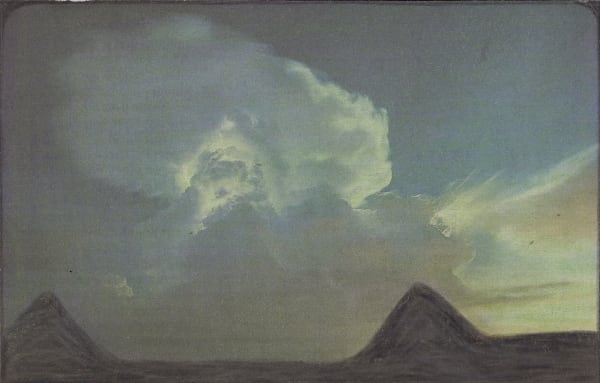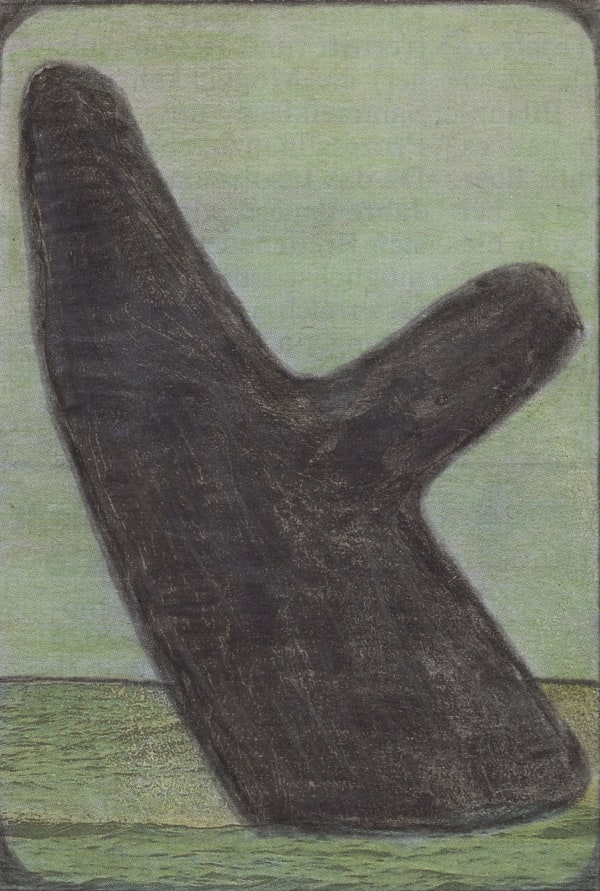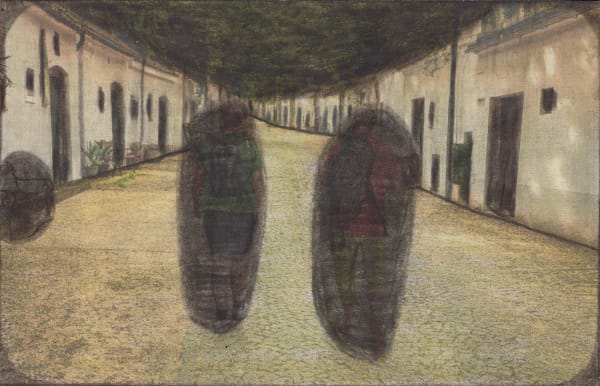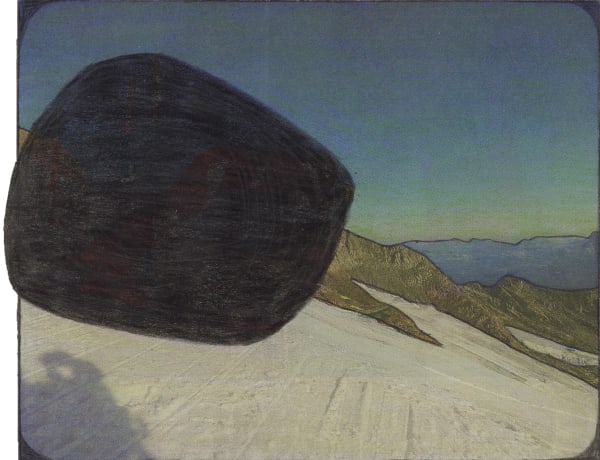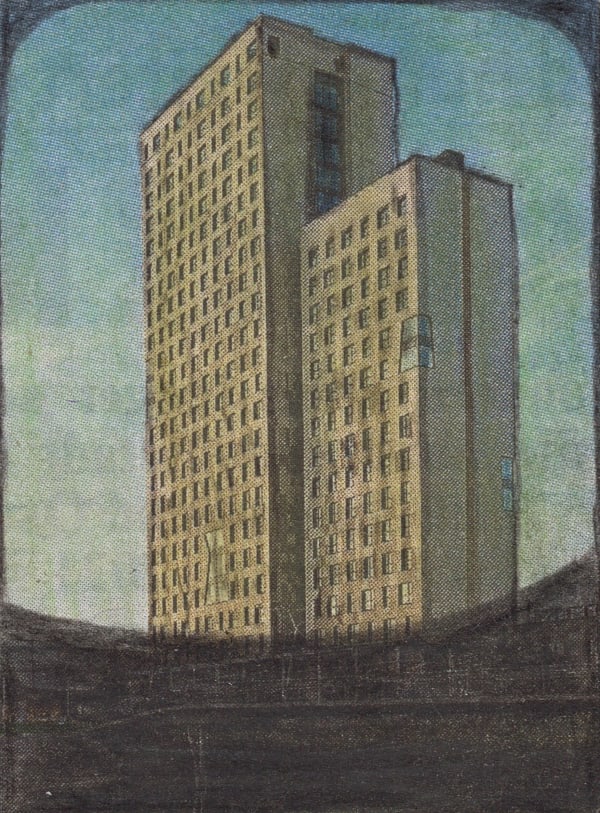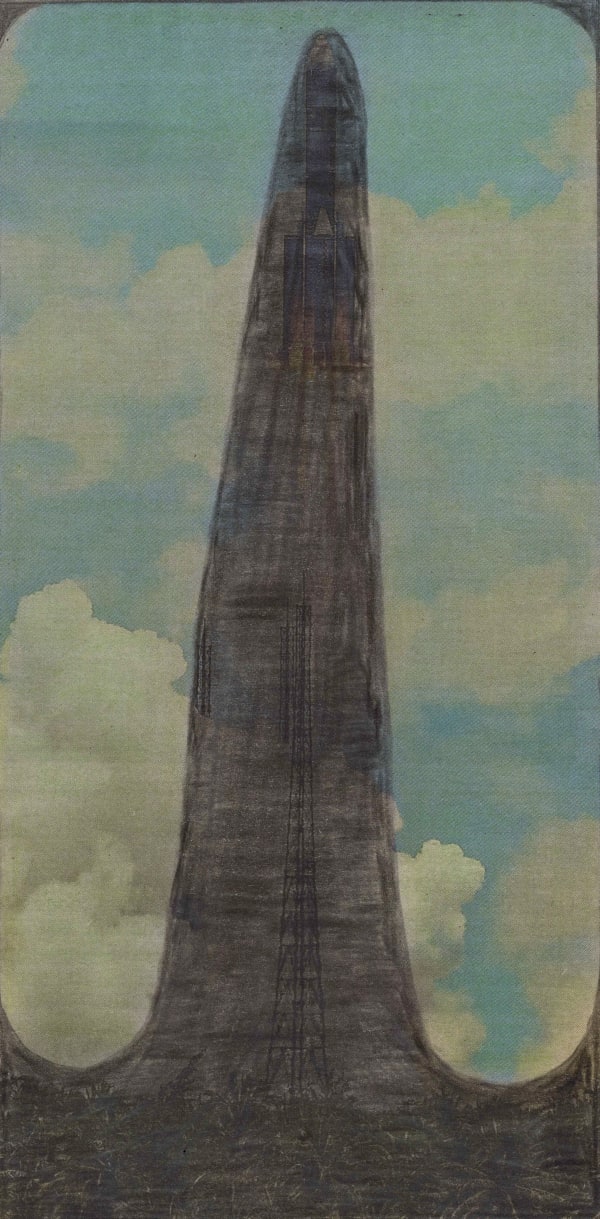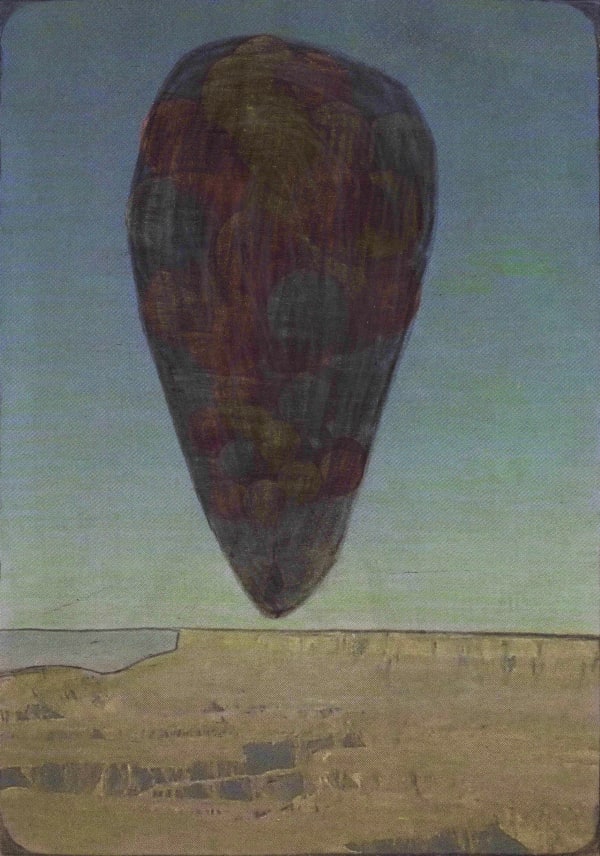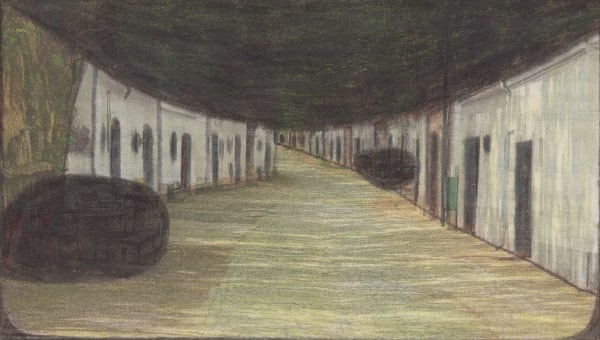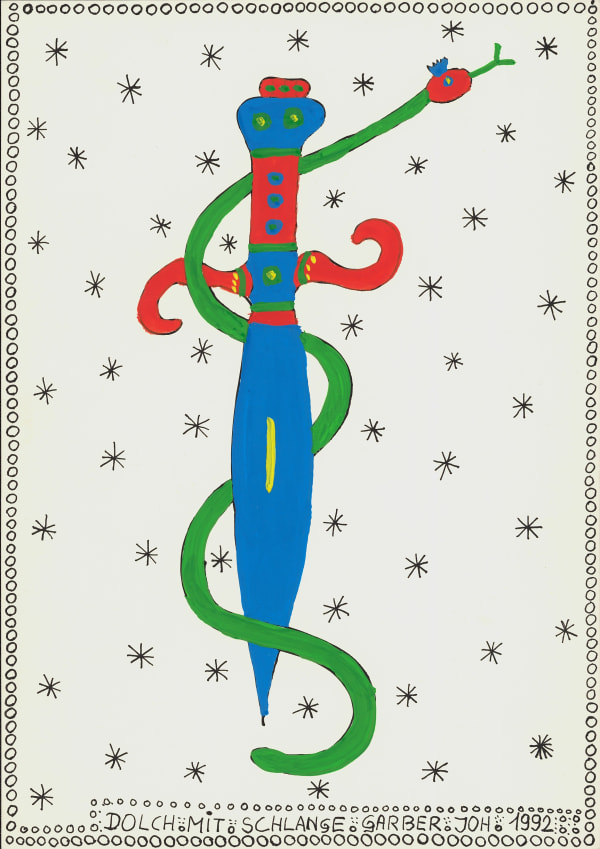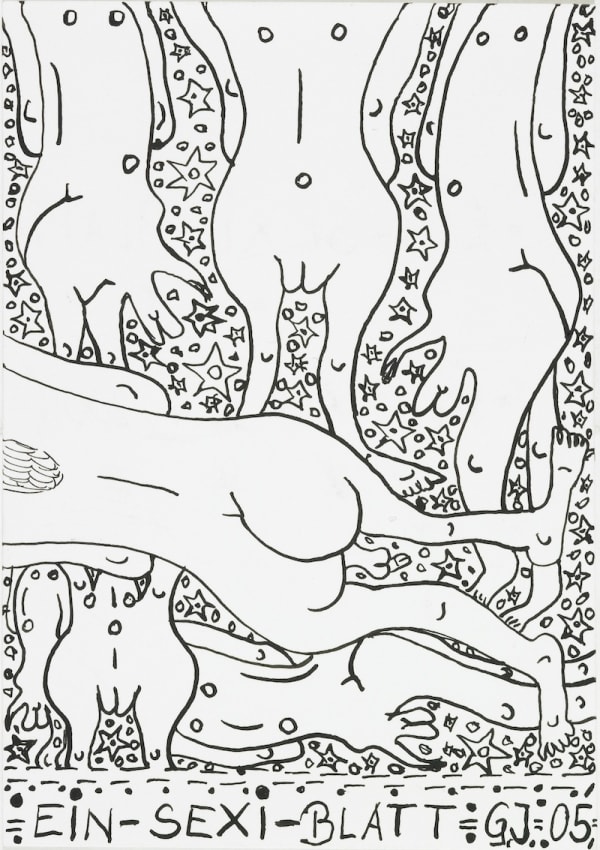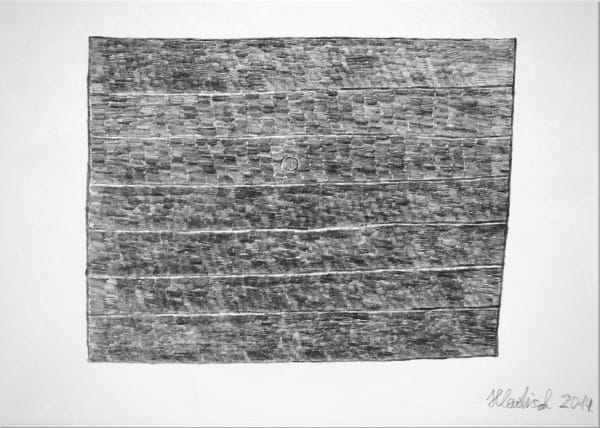Ricco/Maresca Gallery is pleased to present gugging / art brut, a group exhibition featuring over 30 works by seven artists produced from the 1970s to the present at Gugging, Austria’s foremost cultural center dedicated to championing the field of art brut. Spanning across generations of artists who found their calling at Gugging, this exhibition highlights the profound originality and remarkable artistry that this forward-thinking institution has fostered for many decades. gugging / art brut is Ricco/Maresca’s second exhibition featuring artists of Gugging since their debut at the gallery in 2012.
Formerly a psychiatric hospital, Gugging’s genesis as an art brut epicenter began in 1954 when one of its psychiatrists, Dr. Leo Navratil, started to employ a “draw-a-person” test as a diagnostic aid, taking notice of the quality of the drawings that some of his patients produced. This led to the publication of his book Schizophrenia and Art (1965), which explored his growing interest in the intersection of creativity and mental illness and became a hit amongst avant-garde painters such as Arnulf Rainer and Peter Pongratz. Shortly after, Jean Dubuffet, the famed artist who in 1948 had coined the term art brut (“raw art”) to describe art created on the margins of mainstream culture—which he deemed the truest mode of artistic creation—declared works by Gugging patients definitive examples of the movement.
Following the success of the first public exhibition of the artists of Gugging in 1970, Navratil set out to provide better living conditions patients with artistic inclinations. While such plan was met with contempt from the hospital union, Navratil persisted and eventually succeeded in establishing the Centre for Art and Psychotherapy in a vacant building nearby where his “artist-patients” could live and work full-time. Among the first 18 to move in were Johann Hauser (1926 - 1996), an illiterate patient diagnosed with schizophrenia who found a profound new way of self-expression through drawings of engines of war and erotic women; Johann Korec (1937-1980), whose poignant watercolor and ink works that skillfully incorporate text and image form visual language that is both diaristic and observant of the outside world; and Johann Garber (b. 1947), known for his depictions of a paradisiacal universe and its inhabitants often in the form of meticulous ink drawings.
In 1986, with the new director, Dr. Johann Feilacher at the helm, The Center for Art and Psychotherapy was renamed The House of Artists, a change that signified a new direction under which the artist-patients would simply be regarded as artists.
Feilacher’s vision was to raise Gugging artists to the same level of esteem enjoyed by their modern and contemporary counterparts. His novel method of promoting the art, which included direct sales and institutional exhibitions, played a crucial role in Gugging's subsequent development into an essential force in the field of art brut.
Today, Gugging boasts its own museum, a gallery, and an atelier (open to non-residents), where guest artists like Alfred Neumayr (b. 1958) and Leopold Strobl (b. 1960) have found both inner peace in artmaking and international notoriety—notably, the Museum of Modern Art in New York acquired five Strobl drawings in 2016. Among the new generation of residents at the House of Artists are Helmut Hladisch (b. 1961) whose fine-line drawings of everyday objects oscillate between abstraction and representation, and
Günther Schützenhöfer (b. 1965), whose idiosyncratic handling of the graphite medium and unique approach to planar depth has positioned him as one of the most important artists of contemporary art brut.
-
Günther Schützenhöfer
(b. 1965)-
 Television, 2013Graphite and colored pencil on paper17.3 x 24.6 in. (44 x 62.4 cm.)(GSG 99)SOLD
Television, 2013Graphite and colored pencil on paper17.3 x 24.6 in. (44 x 62.4 cm.)(GSG 99)SOLD -
 Eiffel Tower, 2016Graphite on paper27.6 x 19.7 in. (70 x 50 cm.)(GSG 106)SOLD
Eiffel Tower, 2016Graphite on paper27.6 x 19.7 in. (70 x 50 cm.)(GSG 106)SOLD -
 Helicopter, 2012Graphite and colored pencil on paper19.7 x 25.6 in. (50 x 65 cm.)(GSG 43)SOLD
Helicopter, 2012Graphite and colored pencil on paper19.7 x 25.6 in. (50 x 65 cm.)(GSG 43)SOLD -
 Ferris Wheel, 2018Graphite on paper27.5 x 19.7 in. (70 x 50 cm.)(GSG 113)SOLD
Ferris Wheel, 2018Graphite on paper27.5 x 19.7 in. (70 x 50 cm.)(GSG 113)SOLD
-
 Lawn Mower, 2014Graphite on paper17.3 x 24.6 in. (43.9 x 62.5 cm.)(GSG 74)SOLD
Lawn Mower, 2014Graphite on paper17.3 x 24.6 in. (43.9 x 62.5 cm.)(GSG 74)SOLD -
 Trumpet, 2016Graphite on paper19.7 x 27.5 in. (24.6 x 10.8 cm.)(GSG 118)$7,000
Trumpet, 2016Graphite on paper19.7 x 27.5 in. (24.6 x 10.8 cm.)(GSG 118)$7,000 -
 Sunshade, 2019Graphite on paper27.5 x 19.8 in. (70 x 50 cm.)(GSG 116)$7,000
Sunshade, 2019Graphite on paper27.5 x 19.8 in. (70 x 50 cm.)(GSG 116)$7,000 -
 Bottle, 2019Graphite on paper27.6 x 19.7 x in. (70.1 x 50 cm.)(GSG 120)$7,000
Bottle, 2019Graphite on paper27.6 x 19.7 x in. (70.1 x 50 cm.)(GSG 120)$7,000
-
 Untitled, 2017Graphite and colored pencil on paper19.7 x 27.6 in. (50 x 70.1 cm.)(GSG 121)SOLD
Untitled, 2017Graphite and colored pencil on paper19.7 x 27.6 in. (50 x 70.1 cm.)(GSG 121)SOLD -
 Untitled, 2017Graphite on paper19.7 x 27.6 in. (50 x 70.1 cm.)(GSG 119)$7,000
Untitled, 2017Graphite on paper19.7 x 27.6 in. (50 x 70.1 cm.)(GSG 119)$7,000 -
 Butterfly, 2017Graphite on paper16.5 x 23.4 in. (42 x 59.5 cm.)(GSG 110)$6,500
Butterfly, 2017Graphite on paper16.5 x 23.4 in. (42 x 59.5 cm.)(GSG 110)$6,500 -
 A Car, 2012Pencil and colored pencil on paper19.75 x 25.5 in. (50.2 x 64.8 cm.)(GSG 66)SOLD
A Car, 2012Pencil and colored pencil on paper19.75 x 25.5 in. (50.2 x 64.8 cm.)(GSG 66)SOLD
-
-
Günther Schützenhöfer was born in Mödling, Austria. As a six-year-old, he arrived at the former Gugging Clinic and spent his life in various care facilities until 1999, when aged 34, he moved into the Gugging House of Artists, where he produced his first drawings. Over the past 15 years, Schützenhöfer has developed a unique, unmistakable style. He portrays elements from his surroundings in an abstracted, self-contained manner, which is joyfully unconcerned with perspective; nearly enigmatic yet always permeated by the artist’s subtle humor.
At first, Schützenhöfer worked very cautiously and mostly in small formats. Over time, the formats have grown larger; fine lines giving way to bold, determined strokes. He works in pencil and colored pencils on paper and cardboard. He sketches out his theme in a few lines, then uses stronger pressure with his pencil to bring it to life. Sometimes this pressure will break the pencil; for this reason, the artist keeps at least five sharpened pencils readily available, and once he has used them all, he will grab any other pencils lying around on the table. This constant change in pencils of different grades and the varying touch he applies, results in idiosyncratic shadings and a soft, almost furry texture.
Schützenhöfer chooses his themes spontaneously, often related to the current season or situation. His approach is entirely focused on the essence, the gist of his theme. Limiting himself to the vital elements, he produces drawings and compositions that are unique in their overall sophistication. Schützenhöfer’s works have been shown worldwide since 2001 and are represented in numerous private and public collections, such as the Lower Austria Regional Collection, the Museum of Everything, the Peter Infeld Private Trust, and the Arnulf Rainer Collection.
-
Johann Korec
(1937 - 2008) -
Johann Korec grew up in orphanages in Vienna and from age thirteen worked as a farm laborer and shepherd. His dream was to care for animals in a circus, but manic depression and hypomania led to his commitment to the Maria Gugging Psychiatric Clinic just north of Vienna in 1958. Only four years earlier, psychiatrist Leo Navratil had administered diagnostic drawing tests to his patients at the clinic, discovering that several of them had artistic talent. Navratil’s first book “Schizophrenia and Art” was published in 1965. In 1970 the Gugging artists had their first exhibition in the Viennese Galerie nächst St. Stephan. By 1981 all artistically talented patients at Gugging (including Korec) were housed under one roof—the Center for Art-Psychotherapy—and exhibitions featuring their work began to appear throughout Europe.Korec’s interest in art emerged in the 1960s, when he started collecting images from print media and tracing the figures that appealed to him. At one point, he began to combine the tracings with his own compositions—retracing all contours with India ink and filling them with watercolors. Narrative is an essential graphic component of each work, a pictorial diary documenting the story unfolding in the artist’s mind.
-
Johann Hauser
(1926 - 1996) -
Johann Hauser showed signs of mental disability and social dissociation from a young age and attended a school for feeble-minded children through the second grade. However, he remained illiterate and never learned to write or the logic of numbers. The artist was born in Bratislava, Slovakia, but his family spoke German. In 1943, towards the end of World War II, he moved with his mother to Lower Austria, he was then 17 years old and immediately committed to the Mauer-Öhling state psychiatric hospital. Sometime before 1950, he was transferred to the Maria Gugging State Psychiatric Clinic, where he was diagnosed with schizophrenia and produced his first drawings with the encouragement of Dr. Leo Navratil. The artist was one of the original residents of the Gugging House of Artists, where he lived from 1981 until his death, and its most celebrated to this day.
Despite being a mental patient for most of his life, Hauser achieved international recognition as an artist while still alive. Normally working with colored pencils, graphite, and crayons, he created both intensely gestural drawings in dramatic, unapologetic palettes and minimalist compositions representing single centralized forms. This technical fluctuation, according to Dr. Navratil, occurred due to Hauser’s mental state—with manic episodes yielding larger, vibrant works (with a painterly and almost aggressive application of color) and depressive episodes leading to smaller, abstracted, or geometric works. Hauser’s personal iconography ranged from animals, everyday objects, aircrafts and machinery, to human subjects. He drew inspiration and imagery from popular culture and printed media, which he then re-imagined through his unique style and in defiance of the rules of perspective and proportion.
Hauser influenced Dr. Navratil’s development of a non-psychiatric approach to treating creative asylum patients and his oeuvre was shown widely across Europe in the 1970s. In 1979, he had his first major one-person exhibition at the municipal gallery in Munich's Lenbachhaus, that same year he was included in Victor Musgrave’s groundbreaking show “Outsiders” at the Hayward Gallery in London, where he met Roger Cardinal. In later years, he was exhibited worldwide, including exhibitions at the Museum of Modern Art in Vienna, the Los Angeles County Museum of Art, The Setagaya Art Museum in Tokyo, and the Weserburg Museum in Bremen. Hauser’s work can be found in the Collection de l’Art brut (Lausanne, Switzerland), the Lille Métropole Museum of Modern, Contemporary and Outsider Art (Villeneuve-d'Ascq, France), the Abcd Collection (Paris), the Arnulf Rainer Collection (Vienna), the Treger Saint Silvestre Collection (São João da Madeira, Portugal), Intuit: The Center for Intuitive and Outsider Art (Chicago), the Philadelphia Museum of Art, and the Museum of Modern Art (New York). -
Leopold Strobl
(b. 1960)-
 Untitled , 2020Graphite and colored pencils on newsprint clip mounted on paper3 3/4 x 5 3/4 in. (9.4 x 14.6 cm.)(LpS 379)
Untitled , 2020Graphite and colored pencils on newsprint clip mounted on paper3 3/4 x 5 3/4 in. (9.4 x 14.6 cm.)(LpS 379) -
 Untitled, 2020Graphite and colored pencils on newsprint clip mounted on paper4 1/8 x 2 3/4 in. (10.4 x 7.1 cm.)(LpS 382)
Untitled, 2020Graphite and colored pencils on newsprint clip mounted on paper4 1/8 x 2 3/4 in. (10.4 x 7.1 cm.)(LpS 382) -
 Untitled , 2020Graphite and colored pencils on newsprint clip mounted on paper3 1/8 x 4 3/4 in. (7.7 x 11.9 cm.)(LpS 377)
Untitled , 2020Graphite and colored pencils on newsprint clip mounted on paper3 1/8 x 4 3/4 in. (7.7 x 11.9 cm.)(LpS 377) -
 Untitled , 2020Graphite and colored pencils on newsprint clip mounted on paper4 3/8 x 5 5/8 in. (11 x 14.2 cm.)(LpS 380)SOLD
Untitled , 2020Graphite and colored pencils on newsprint clip mounted on paper4 3/8 x 5 5/8 in. (11 x 14.2 cm.)(LpS 380)SOLD
-
 Untitled , 2020Graphite and colored pencils on newsprint clip mounted on paper3 7/8 x 5 3/4 in. (9.7 x 14.6 cm.)(LpS 374)SOLD
Untitled , 2020Graphite and colored pencils on newsprint clip mounted on paper3 7/8 x 5 3/4 in. (9.7 x 14.6 cm.)(LpS 374)SOLD -
 Untitled , 2020Graphite and colored pencils on newsprint clip mounted on paper2 1/4 x 1 3/4 in. (5.8 x 4.3 cm.)(LpS 381)SOLD
Untitled , 2020Graphite and colored pencils on newsprint clip mounted on paper2 1/4 x 1 3/4 in. (5.8 x 4.3 cm.)(LpS 381)SOLD -
 Untitled , 2020Graphite and colored pencils on newsprint clip mounted on paper7 1/2 x 3 3/4 in. (19.1 x 9.5 cm.)(LpS 375)
Untitled , 2020Graphite and colored pencils on newsprint clip mounted on paper7 1/2 x 3 3/4 in. (19.1 x 9.5 cm.)(LpS 375) -
 Untitled , 2020Graphite and colored pencils on newsprint clip mounted on paper5 3/8 x 3 3/4 in. (13.7 x 9.6 cm.)(LpS 376)
Untitled , 2020Graphite and colored pencils on newsprint clip mounted on paper5 3/8 x 3 3/4 in. (13.7 x 9.6 cm.)(LpS 376)
-
-
Strobl was born in Mistelbach, Lower Austria. He has been devoted to art since his early twenties, but the visual language for which he is known is a relatively recent development--only about six years in the making. Strobl has been a guest of the Open Studio program at the Gugging Art Brut center for more than 16 years. He works almost every day, starting in the early hours of the morning, and completes one drawing daily. This impetus is significant both in terms of form and content: the artist’s works are generally no bigger than 8 ½ inches on the longest side and can be almost as small as a postage stamp; they come to the artist as little visual epiphanies and strike the viewer with this poetic immediacy.
A "classic" Strobl work, elegant in both execution and subject, will feature shrouded figures literally transformed into a graphite topography; lone peaks, sinuous hills, and boulder-like shapes in landscapes overlooked by luminous green-blue skies. The artist is a perceptive colorist and imbues his world with shades green, grey, yellow, blue, and ivory white—blending and layering pigment onto large areas with an eye toward the existing texture and light in the underlying photograph—so that ultimately, we don't know where the artist's touch ends and the found image begins.
Strobl's debut exhibition in the United States took place at Ricco/Maresca Gallery in the spring of 2016. In 2018 the Museum of Modern Art in New York acquired five works by the artist for its permanent collection.
-
Johann Garber
(b. 1947) -
Johann Garber began producing work in the late 1970s within the Lower Austrian Psychiatric Hospital in the village of Gugging, outside Vienna, where he was first admitted at age 19. He is a prominent member of the Gugging Artist Group, consisting of long-term psychiatric in-patients at the hospital—chosen by the psychiatrist Dr. Leo Navratil because of their artistic abilities ... Garber’s pictorial obsessions with sex and sexuality were thus allowed to develop into a sustained art practice ... [He] gives his erotic drawings the generic name “Sexi-Blatt” (Sexy Sheet/Paper). The shallow, almost claustrophobic spaces of these densely worked images speak to the horror vacui, or fear of empty space, that was long regarded as symptomatic of certain types of mental illness. The drawings are packed with erotic imagery. Naked men and women cavort throughout both pastoral and city scenes ... The regular use of accessories like clerical regalia and liturgical implements adds a certain suggestive, irreverent spice. Great, heavy male gonads are among Garber’s favorite devices; thick, erect penises and generously-filled scrotums that are fixed improbably to the fronts of men. Both male and female figures sport muscly, protruding buttocks that seem to defy gravity. The images here are reminiscent of some wild fantasy of Romanticism, in which Nature itself is dripping with procreative sensuality. -Colin Rhodes
-
Alfred Neumayr
(b. 1958) -
Alfred Neumayr was born in Tulln (Lower Austria). He works primarily with indian inks or pencil—which he applies and scratches out, thins down or mixes. His modus operandi is reminiscent of surrealist automatism: starting at a random point and letting his hand glide without restraint until the innumerable lines reveal a motif that he then elaborates on. The resulting images resemble geographical formations, photos from outer space, fantasy worlds or mythical creatures. Minute details appear as figures or faces; the various thicknesses of his pen strokes and the rhythmic structures into which they are linked make his pictures come alive. Neumayr’s diffuse representations leave ample room for association and interpretation: waves seen from a bird’s eye perspective, animal hoards or battle scenes may reveal themselves to the viewer.
Encouraged by a friend, Neumayr (a trained offset printer) began his artistic activity in 2005. In early 2011 he became a daily visitor of the Atelier Gugging.
The artist’s work can be seen at the Collection de l’Art Brut in Lausanne and the Diamond Collection in Vienna. -
Helmut Hladisch
(b. 1961)-
 Cone, 2015Graphite on paper11.7 x 8.3 in. (29.7 x 21 cm.)(HH 13)$3,000
Cone, 2015Graphite on paper11.7 x 8.3 in. (29.7 x 21 cm.)(HH 13)$3,000 -
 Shoe box, 2014Graphite on paper8.3 x 11.7 in. (21 x 29.7 cm.)(HH 10)$3,000
Shoe box, 2014Graphite on paper8.3 x 11.7 in. (21 x 29.7 cm.)(HH 10)$3,000 -
 Pyramid, 2015Graphite and colored pencil on paper8.2 x 11.7 in. (20.9 x 29.6 cm.)(HH 18)$3,000
Pyramid, 2015Graphite and colored pencil on paper8.2 x 11.7 in. (20.9 x 29.6 cm.)(HH 18)$3,000 -
 Coffee brewer, 2015Graphite on paper11.7 x 8.3 in. (29.7 x 21 cm.)(HH 19)$3,000
Coffee brewer, 2015Graphite on paper11.7 x 8.3 in. (29.7 x 21 cm.)(HH 19)$3,000
-
-
Helmut Hladisch has been one of the eight residents of the Gugging House of Artists in the outskirts of Vienna since 2013. Using short, close-set strokes to fill in traced contours, Hladisch depicts everyday objects from memory or inspired by print media. His stylized drawings marry emotional intensity, imagination, ingenuity, and technical precision—crossing seamlessly into the modern and contemporary arenas.
-


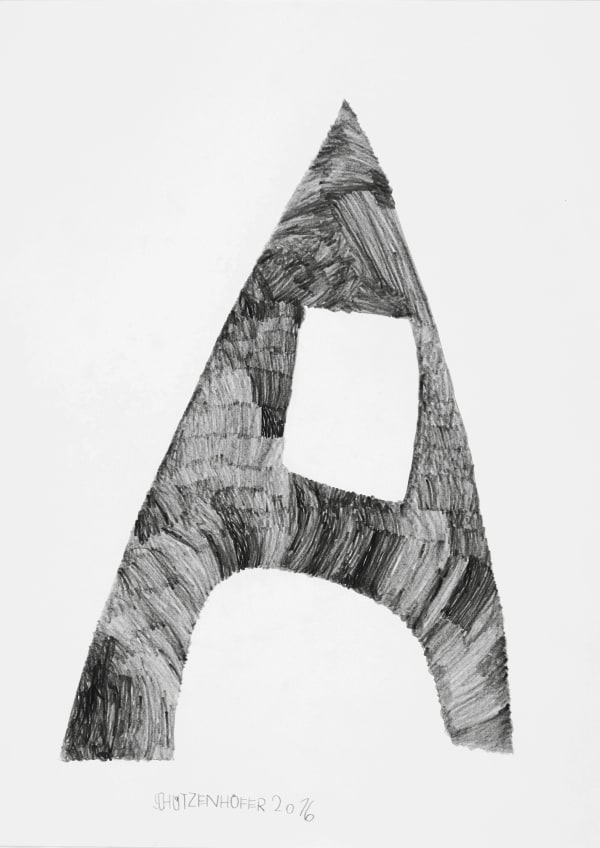















![Untitled (Lion Head), 1984 Colored pencil and graphite on paper 11.9 x 15.9 in. (30 x 40 cm.) (JH 4) [Private Collection]](https://artlogic-res.cloudinary.com/w_600,c_limit,f_auto,fl_lossy,q_auto/ws-artlogicwebsite0078/usr/exhibitions/images/feature_panels/710/jh-4-image-1-.jpg)
![Rocket, 1971 Colored pencil and graphite on paper 8.25 x 11.5 in. (21 x 29.2 cm.) (JH 8) [Private Collection]](https://artlogic-res.cloudinary.com/w_600,c_limit,f_auto,fl_lossy,q_auto/ws-artlogicwebsite0078/usr/exhibitions/images/feature_panels/710/jh-8-image-1-.jpg)
